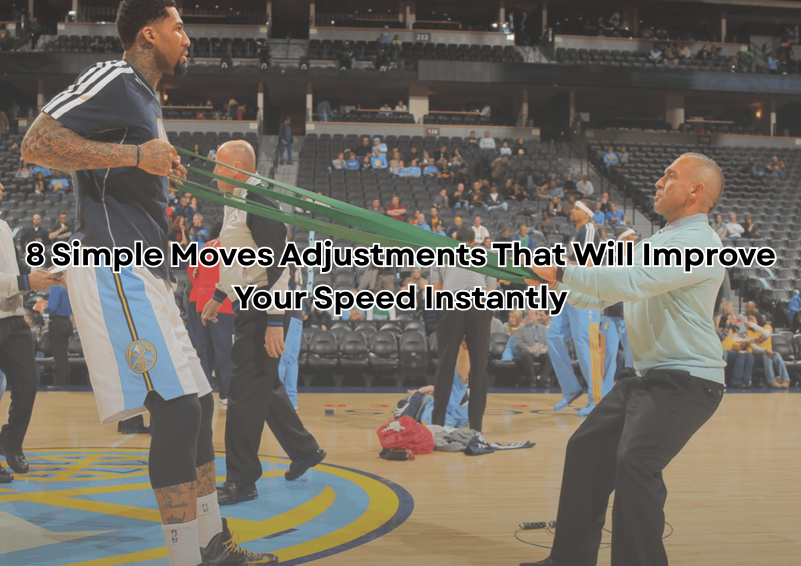
Speed in basketball comes from details the camera rarely notices. The best NBA and WNBA athletes fix small things in training that change everything about how they move. A different shin angle. A cleaner foot strike. A hip that opens at the right second. I have watched players go from solid to explosive without adding muscle or adding drills. They simply learned how to organize their body the way sprinters do. These eight adjustments come from real moments where a star unlocked something new, and once they felt it, their speed never dipped again.
Context: Why speed adjustments matter
Basketball speed is rarely pure sprinting. It is the way a player shifts weight, loads the back leg, and frees the hips. Most players slow themselves down without knowing it. A stiff shoulder or a wrong entry angle can erase the advantage they think they have.
The fastest NBA and WNBA players worked on these same details. They never relied only on natural talent. They fixed mechanics, made tiny adjustments, and trusted repetition.
Speed shows up in bursts. If you train those bursts with intention, you gain ground every time.
Methodology: These adjustments are grounded in official interviews, documented training habits, and verified performance data from NBA and WNBA stars. Rankings prioritize repeatable movement gains and clarity of skill application. Ties are settled by the simplicity of the adjustment and its immediate on court value.
The Moves That Change Everything
1. Shin angle reset
Ja Morant changed his acceleration in 2021 with one cue. Lower the front shin before the first step. During a preseason session his trainer nudged his knee forward and told him to lean into the floor. That tiny adjustment launched him toward the rim with less effort.
A low shin angle increases horizontal force. He recorded some of the fastest first step speeds by player tracking that season. His burst looked like he was pulled forward instead of pushing.
A coach said he moved as if the floor tilted for him.
Lower the angle and the ground starts working with you.
2. Hip turn release
Aja Wilson trains hip turns like they are footwork. She snaps her inside hip early when defending or attacking, opening her body toward her lane before her feet follow.
Players who open the hip first reach acceleration sooner. Wilson’s short burst closing numbers are near the top among WNBA forwards, and film shows her beating players who look just as quick on paper.
Teammates joke that she cheats the angle. But it is pure mechanics.
Turn the hip and the rest of your body stops fighting itself.
3. Foot strike clean up
Sue Bird once explained how she improved her speed by cleaning up her foot strike. She shifted from heel to midfoot, focusing on quiet steps in training. Quieter steps meant less contact time and more speed.
Biomechanics back it up. Midfoot strikes reduce braking forces. When she made the change her short distance tests improved enough that coaches had younger guards study her stride.
Her trainer said she moved like she stopped touching the floor.
Fix the strike and you gain free speed.
4. Load step timing
Shai Gilgeous Alexander became one of the most efficient drivers in the league by perfecting his load step. In a summer workout he caught the ball, waited for a breath, then pushed off the back leg at the exact moment the defender relaxed.
Load steps are half of first step success. A mistimed load cancels the burst. A perfectly timed one breaks angles. His acceleration metrics climbed and he ranked high in drive efficiency.
A teammate said he moves like he knows the defender’s pulse.
Time the load and you control the race.
5. Arm swing correction
Sylvia Fowles worked on freeing her shoulders during her prime Minnesota stretch. Her trainer told her to focus on pulling her elbows back through her rib line in her first three steps.
Clean arm swing increases rhythm and reduces upper body tension. When she fixed it, her transition numbers improved, and you could see how much smoother she ate up space. Even late in her career she beat guards down the floor because her arms matched her legs.
A coach said her shoulders finally stopped holding her prisoner.
If your arms stay tight, your speed never shows up.
6. Core to hip connection
Brittney Griner trained her hip rotation with a simple cue during her peak Phoenix seasons. Tighten the ribs, release the hip. It sharpened her acceleration and helped her explode into early seal runs.
Sports science says better rib to hip sequencing multiplies rotation speed. When she locked this in her short burst numbers improved and she created angles faster than players her size usually can.
A staff member said she repeated the same quiet drill until the movement felt like a breath.
When the core and hips talk to each other, acceleration becomes automatic.
7. Eyes before feet cue
Chris Paul always said that he moves his eyes before he moves his feet. He looks at the lane he wants before the step happens, giving his brain a head start on the burst.
Reaction speed is measurable. Players who process faster accelerate sooner. Paul ranked near the top of short acceleration metrics in multiple seasons because his eyes triggered the movement early.
Teammates said he sees the next two steps before you notice the first one.
Eyes lead the body. Move them first and your speed jumps.
8. Breath control reset
Breanna Stewart connects her breath to her acceleration. Inhale to load. Sharp exhale to explode. During the 2018 title run her transition speed looked lighter because she stopped fighting tension.
Breath control relaxes the upper body and lets the legs fire cleanly. When she applied it her top speed in open floor plays rose and she held that pace longer.
A coach said she moved like she dropped invisible weight.
Your breath sets your speed. Get it right and everything else smooths out.
What Comes Next
Speed evolves every season. New players enter the league and bring their own tricks, their own mechanics, their own small discoveries. Someone is going to take one of these eight adjustments and push it further than anyone expects.
The future of basketball quickness will not come from running harder. It will come from understanding movement deeper.
So here is the real question. Who finds the next hidden adjustment that changes everything again?
Also Read: https://info-vista.com/exercises-for-core-strength-underrated-list/



